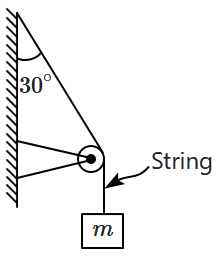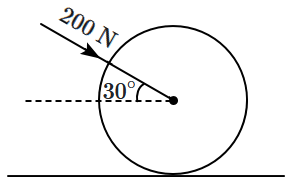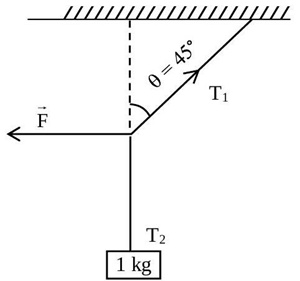A person standing on a spring balance inside a stationary lift measures \(60\) kg. The weight of that person if the lift descends with the uniform downward acceleration of \(1.8\) m/s2 will be: [g \( = 10 \) m/s2 ]
1. \(321\) N
2. \(214\) N
3. \(163\) N
4. \(492\) N
Subtopic: Tension & Normal Reaction |
83%
From NCERT
JEE
Please attempt this question first.
Hints
Please attempt this question first.
A monkey of mass \(50~\text{kg}\) climbs on a rope which can withstand the tension \((T)\) of \(350~\text{N}\). The monkey initially climbs down with an acceleration of \(4~\text{m/s}^2\) and then climbs up with an acceleration of \(5~\text{m/s}^2.\)
(take \(g=10~\text{m/s}^2\))
Choose the correct option from the given ones:
(take \(g=10~\text{m/s}^2\))
Choose the correct option from the given ones:
| 1. | \(T=700~\text N\) while climbing upward. |
| 2. | \(T=350~\text N\) while going downward. |
| 3. | The rope will break while the monkey climbs upward. |
| 4. | The rope will break while the monkey goes downward. |
Subtopic: Tension & Normal Reaction |
71%
From NCERT
JEE
Please attempt this question first.
Hints
Please attempt this question first.
A block remains in equilibrium as shown. If the mass, \(m=\sqrt{3}\) kg, what is the tension in the string?


| 1. | \(\sqrt{3}g\) N | 2. | \(3g\) N |
| 3. | \(\dfrac{g}{2}\) N | 4. | \(\dfrac{g}{\sqrt{3}}\) N |
Subtopic: Tension & Normal Reaction |
65%
From NCERT
JEE
Please attempt this question first.
Hints
Please attempt this question first.
A force \(200 ~\text N\) is exerted on a disc of mass \(70~\text{kg}\) as shown in the figure. What is the normal reaction given by the ground on the disc?

1. \(200~\text{N}\)
2. \(600~\text{N}\)
3. \(800~\text{N}\)
4. \(\dfrac{200}{\sqrt{3}}~\text{N}\)

1. \(200~\text{N}\)
2. \(600~\text{N}\)
3. \(800~\text{N}\)
4. \(\dfrac{200}{\sqrt{3}}~\text{N}\)
Subtopic: Tension & Normal Reaction |
68%
From NCERT
JEE
Please attempt this question first.
Hints
Please attempt this question first.
A \(1\) kg mass is suspended from the ceiling by a rope of length 4 m. A horizontal force 'F' is applied at the midpoint of the rope so that the rope makes an angle of \(45^{\circ}\) with respect to the vertical axis as shown in figure. The magnitude of F is: (Assume that the system is in equilibrium and g = 10 m/s2)

1. \(10~ N\)
2. \(1~ N\)
3. \(\frac{10}{\sqrt{2}} \mathrm{~N}\)
4. \(\frac{1}{10 \times \sqrt{2}} \mathrm{~N}\)

1. \(10~ N\)
2. \(1~ N\)
3. \(\frac{10}{\sqrt{2}} \mathrm{~N}\)
4. \(\frac{1}{10 \times \sqrt{2}} \mathrm{~N}\)
Subtopic: Tension & Normal Reaction |
79%
Please attempt this question first.
Hints
Please attempt this question first.


